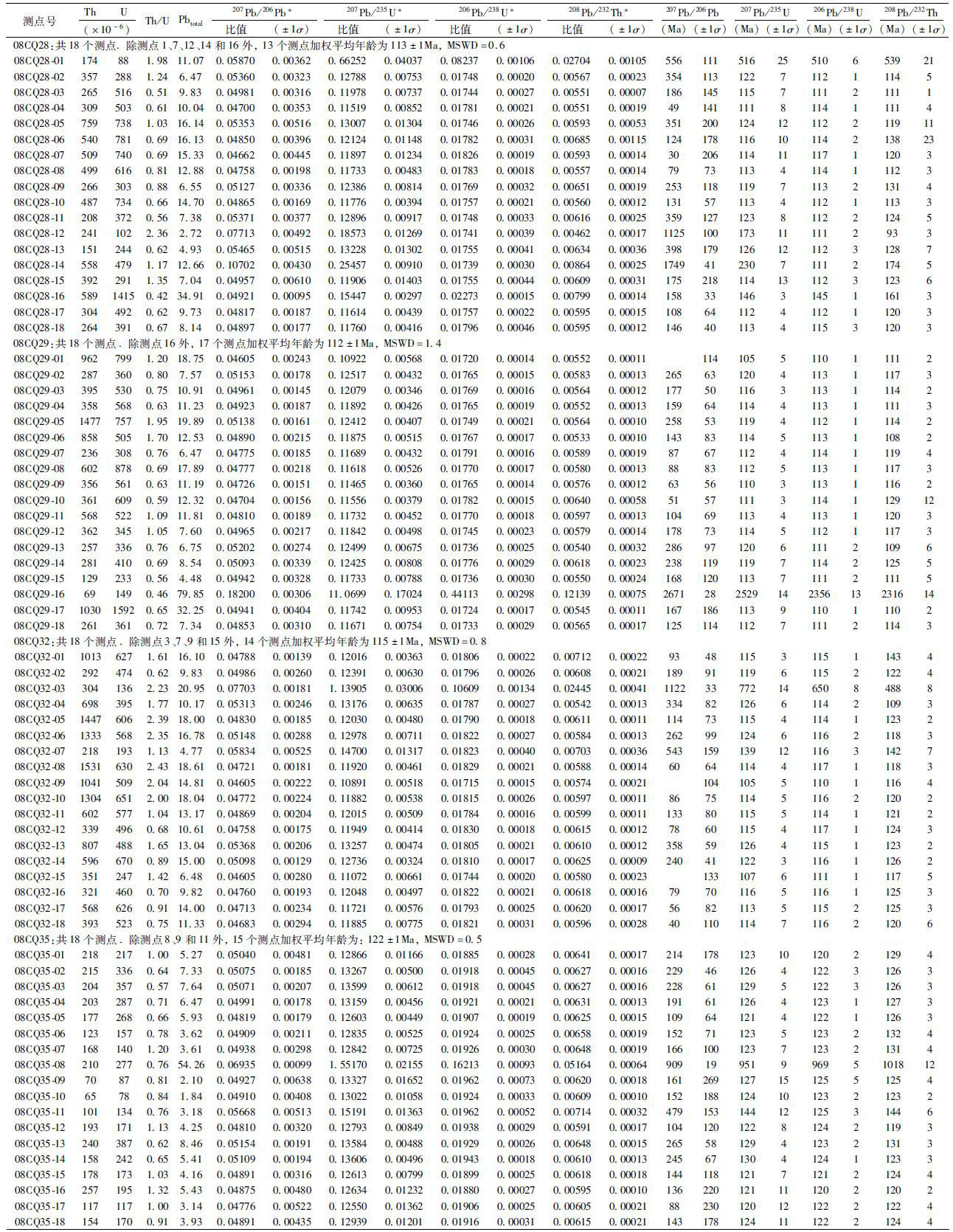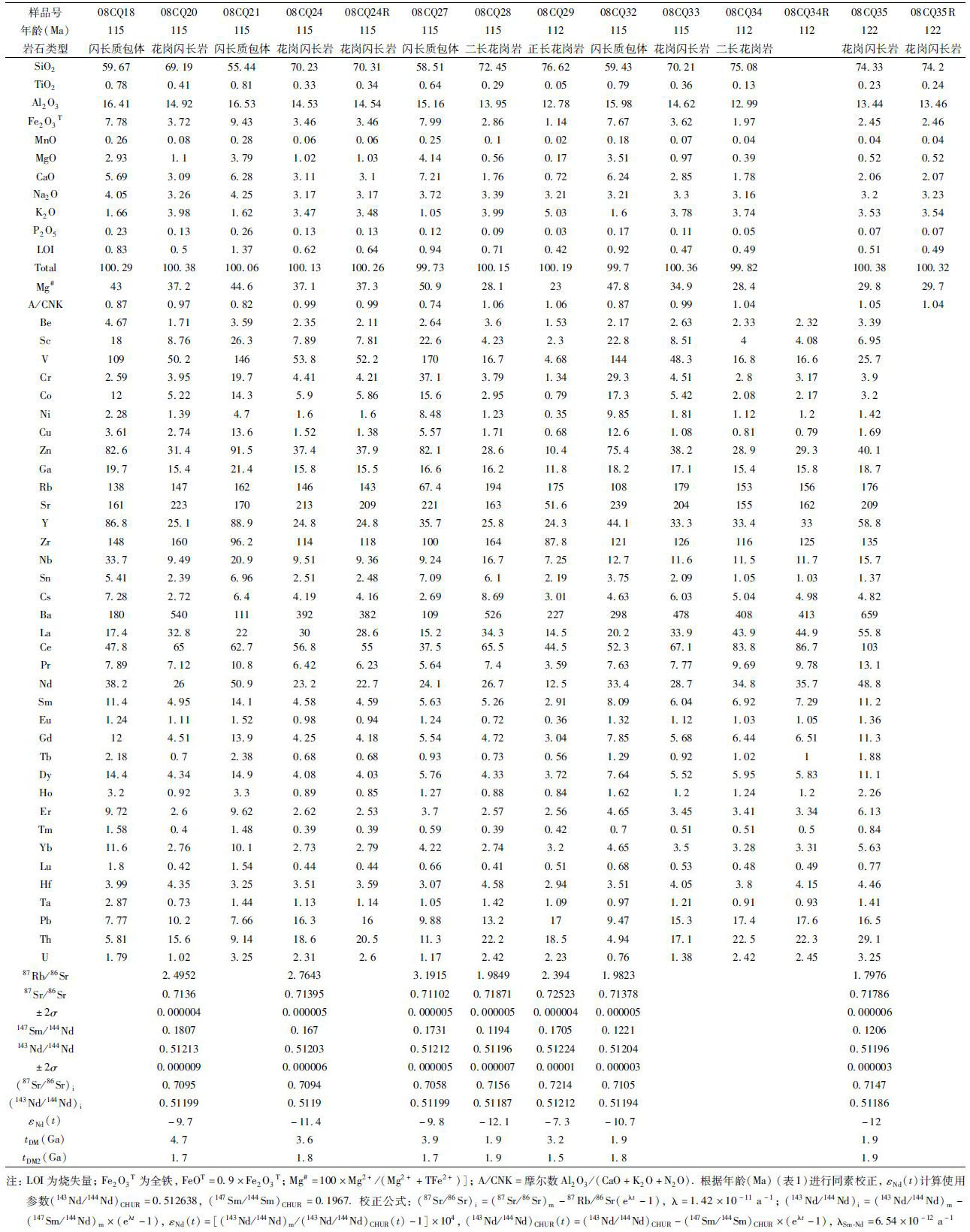2. 防灾科技学院, 三河 101601;
3. 地质过程与矿产资源国家重点实验室, 中国地质大学, 武汉 430074
2. Institute of Disaster Prevention, Sanhe 101601, China;
3. State Key Laboratory of Geological Processes and Mineral Resources, China University of Geosciences, Wuhan 430074, China
拉萨地块是位于中国西南部 (西藏) 班公湖-怒江缝合带以南、雅鲁藏布缝合带以北的一条巨型构造-岩浆岩带 (图 1a,b),通常认为它不但经历了新生代早期的印度-欧亚大陆碰撞,还经历了中生代时期拉萨-羌塘碰撞和新特提斯洋壳岩石圈的北向俯冲 (Copeland et al., 1995; Yin and Harrison, 2000; Wang et al., 2002; Kapp et al., 2005, 2007; Mo et al., 2008; Zhu et al., 2008a, 2009a, b, 2011a; 邓军等, 2011)。作为这些过程的直接产物,拉萨地块广泛发育的中生代 (尤其是早白垩世) 岩浆岩必然记录了与这些过程密切相关的一系列壳幔作用信息。目前对这些早白垩世岩浆岩的时代、岩浆起源和岩石成因,还存在不同看法。例如,对拉萨地块中北部地区的白垩纪岩浆岩,已有观点包括:①为强过铝质S型花岗岩,是拉萨-羌塘碰撞过程中增厚下地壳重熔的产物 (Xu et al., 1985);②为一套由过铝质二云母花岗岩和偏铝质英云闪长岩-辉长岩-闪长岩组成的双峰式岩套,是在俯冲带之上的后碰撞背景中,由上部地壳物质和更深部的地壳物质或上地幔物质部分熔融产生 (Harris et al., 1988);③为强过铝质S型花岗岩,是拉萨-羌塘碰撞后增厚地壳重熔的产物 (Pearce and Mei, 1988; Chiu et al., 2009);④形成于拉萨-羌塘碰撞有关的同碰撞背景,110Ma左右的岩浆作用可能与南向俯冲的班公湖-怒江特提斯洋壳岩石圈的断离有关 (朱弟成等, 2009c; Zhu et al., 2009b, 2011a)。产生这些不同解释的主要原因,很大程度上还在于缺乏高质量的年代学和地球化学数据,并且早期研究多集中于拉萨地块中东部的青藏公路沿线一带,对中西部地区岩浆作用的了解程度较为有限。
在中部拉萨地块,从东部的门巴,到中部的申扎和西部的措勤,都发育大规模早白垩世岩浆岩。更重要的是,在这些早白垩世花岗质岩石中,常见镁铁质包体 (周长勇等, 2008; Zhu et al., 2009b, 2011a; 张晓倩等, 2010; 张亮亮等, 2011)。作为中部拉萨地块代表性的早白垩世岩基之一,措勤南西部的麦嘎岩基中也发育大量闪长质包体,记录了重要的壳幔作用信息,为探讨中部拉萨地块早白垩世时期的岩浆起源和岩石成因提供了机会。本文目的是,在野外调研和岩相学观察基础上,报道措勤麦嘎岩基的锆石U-Pb年代学、全岩地球化学和锆石Hf同位素数据。这些新数据,结合中部拉萨地块已有的同期岩浆岩资料,为探讨中部拉萨地块早白垩世大规模岩浆作用的起源和成因提供了重要约束。
2 地质背景西藏高原由五个东西向延伸的地块组成。从北到南依次由金沙江缝合带 (JSSZ)、龙木错-双湖缝合带 (LSSZ)、班公湖-怒江缝合带 (BNSZ) 和印度-雅鲁藏布缝合带 (IYZSZ) 将其分为松潘-甘孜复理石杂岩带、东羌塘、西羌塘、拉萨地块及喜马拉雅带 (图 1b)(Zhu et al., 2012)。根据沉积盖层和基底性质的不同,以狮泉河-纳木错蛇绿混杂岩带 (SNMZ) 和洛巴堆-米拉山断裂带 (LMF),可将拉萨地块由北向南进一步划分为北部、中部、南部亚地块 (图 1c)(Zhu et al., 2009b, 2011a, b; 朱弟成等, 2009d)。本文涉及的中部拉萨地块,除了出露有大量石炭-二叠纪变沉积序列 (变质砂岩、板岩和千枚岩)、下侏罗统-上白垩统火山沉积序列和中生代尤其是早白垩世岩浆岩外 (Zhu et al., 2012及其中参考文献),还出露少量寒武系、奥陶系、志留系和三叠系及前寒武纪变质地层 (Hu et al., 2005; Ji et al., 2009; Zhu et al., 2012)。中部拉萨地块广泛发育的早白垩世花岗岩类 (约1.6×104km2; 朱弟成等, 2009c),主要侵位于石炭-二叠纪变沉积岩和下白垩统火山沉积地层中,局部被古近纪火山岩不整合覆盖,主要岩性包括花岗闪长岩、二长花岗岩和正长花岗岩等,其中广泛发育闪长质包体 (周长勇等, 2008; 朱弟成等, 2008b; Zhu et al., 2009b, 2010; 张晓倩等, 2010; 刘登忠等, 2003①; 江元生等, 2003②),在措勤地区见较大规模的石英闪长玢岩及辉长岩脉出露 (刘登忠等, 2003)。已有研究表明,中部拉萨地块是一个具有元古代和太古代结晶基底的微陆块,明显不同于以新生地壳为特征的北部和南部拉萨地块 (Zhu et al., 2009a, 2011a, 2012)。
①刘登忠, 陶晓风, 马润则等. 2003.中华人民共和国1:25万区域地质调查报告措勤县幅
②江元生, 周幼云, 李建斌等. 2003.中华人民共和国1: 25万区域地质调查报告措勤区幅
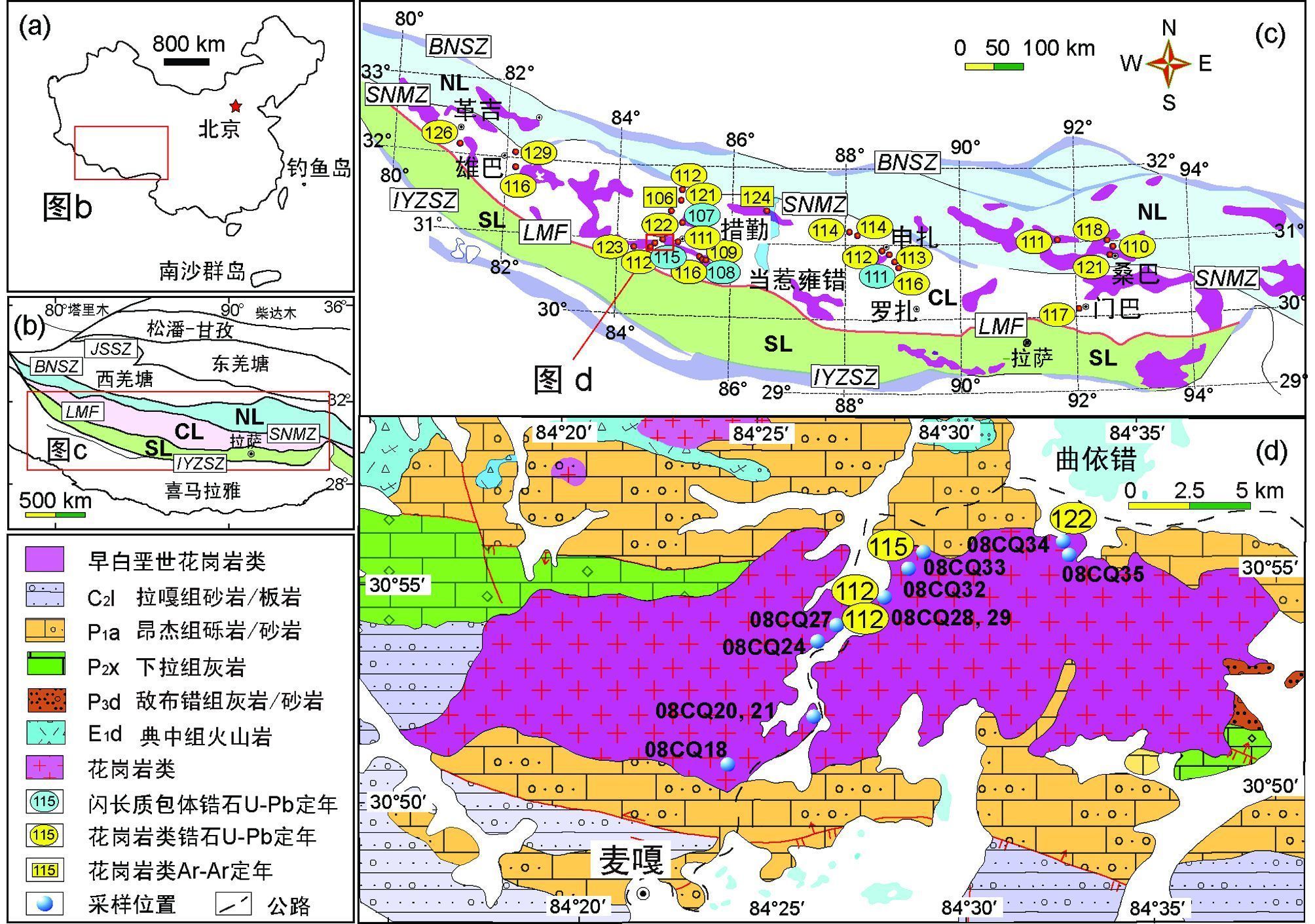
|
图 1 西藏高原构造单元图及措勤麦嘎岩基地质图 (a)-西藏高原地理位置图;(b)-西藏高原构造单元划分图 (据Zhu et al., 2012);(c)-拉萨地块早白垩世花岗质岩分布及部分定年结果 (据Zhu et al., 2011a修改);(d)-研究区地质图及本文采样位置 (据江元生等, 2003修改) Fig. 1 Tectonic subdivision of the Tibetan Plateau and simplified geological map of the Maiga batholith, Coqen |
本文涉及的麦嘎岩基位于措勤县南西约60km的曲依错南,面积约300km2。岩基侵位于上石炭统拉嘎组砂岩/板岩、下二叠统昂杰组粉砂岩/砾岩及中二叠统下拉组灰岩中 (图 1d)(江元生等, 2003)。岩基主要由花岗闪长岩和二长花岗岩等组成,含大量闪长质包体。闪长质包体大小不一,直径几厘米至几十厘米;椭圆状到不规则形状。闪长质包体与寄主岩石之间的接触界线多样 (突变及渐变)。在包体和寄主岩石的接触带上,发育浅色长英质晕圈 (图 2a)。闪长质包体中可见钾长石巨晶 (图 2b) 及石英斑晶。
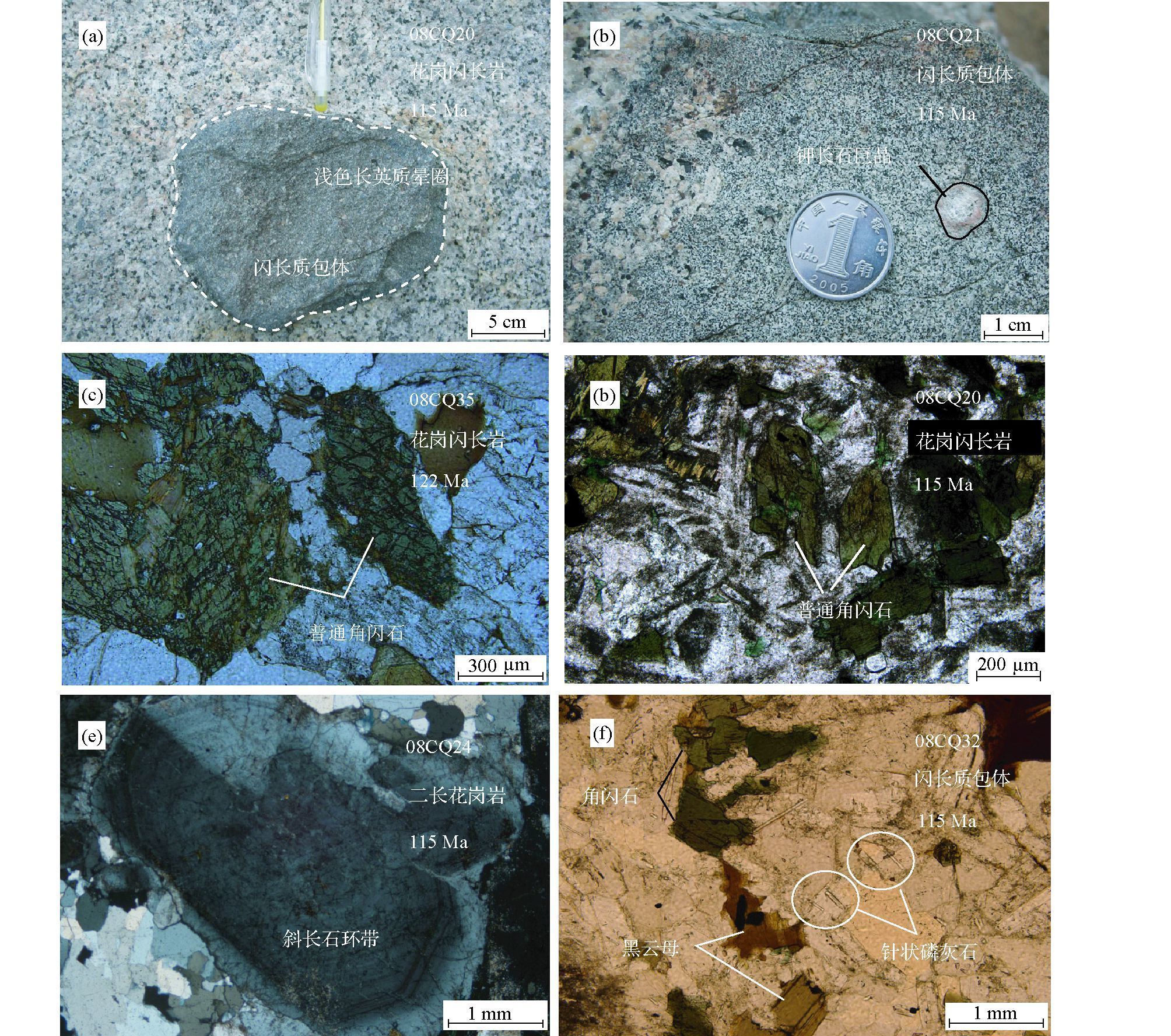
|
图 2 麦嘎岩基花岗质岩石及闪长质包体的野外及岩相学照片 (a)-闪长质包体边部发育的浅色长英质晕圈;(b)-闪长质包体中的钾长石巨晶;(c)-122±1Ma花岗质岩中的普通角闪石;(d)-113±2Ma寄主花岗质岩中的普通角闪石;(e)-花岗质岩石中的斜长石环带结构;(f)-闪长质包体中的针状磷灰石 Fig. 2 Field and petrographical photos of granitoids and dioritic enclaves in the Maiga batholith |
麦嘎岩基花岗闪长岩的矿物组成为斜长石 (35%~45%)、石英 (30%~45%)、钾长石 (10%~20%)、黑云母 (5%~10%) 及角闪石 (<5%)(图 2c,d),副矿物包括磷灰石、锆石及不透明暗色矿物。二长花岗岩与花岗闪长岩的矿物组成相似,但钾长石含量更高 (35%~45%),斜长石含量偏低 (20%~30%)。花岗闪长岩和二长花岗岩的斜长石中均可观察到嵌晶结构、聚片双晶及振荡环带结构 (图 2e)。闪长质包体的矿物组成为斜长石 (30%~55%)、角闪石 (20%~35%)、石英 (5%~20%)、黑云母 (5%~15%)、钾长石 (<15%)、磷灰石 (<3%) 以及不透明暗色矿物 (<2%)。闪长质包体中可见由快速冷凝淬火形成的针状磷灰石 (图 2f)。
3 分析方法锆石是在河北省廊坊市区域地质调查研究所采用浮选和电磁方法挑选的。锆石的阴极发光显微照相 (CL) 是在中国地质科学院地质研究所电子探针实验室中完成,用于检测每个锆石的内部结构及选择合适的分析点位置。锆石U-Pb同位素定年是在中国地质大学 (武汉) 地质过程与矿产资源国家重点实验室中利用LA-ICP-MS仪器完成,实验条件及流程见Zhang et al. (2007)和Liu et al. (2010)。U-Th-Pb元素含量采用美国国家标准物质局人工合成标准硅酸盐玻璃NIST SRM 610作为外标,29Si作为内标进行校正。207Pb/206Pb和206Pb/238U比值使用GLITTER 4.0(Jackson et al., 2004) 计算并用国际标准锆石91500作为外标进行校正。根据207Pb/206Pb和206Pb/238U比值计算出207Pb/235U比值。采用Andersen (2002)中的软件进行普通铅校正。年龄计算及谐和图由ISOPLOT (version 3.0)(Ludwig, 2003) 软件完成。单个分析数据的误差为1σ;206Pb/238U的平均年龄误差为2σ。年龄数据分析结果见表 1。
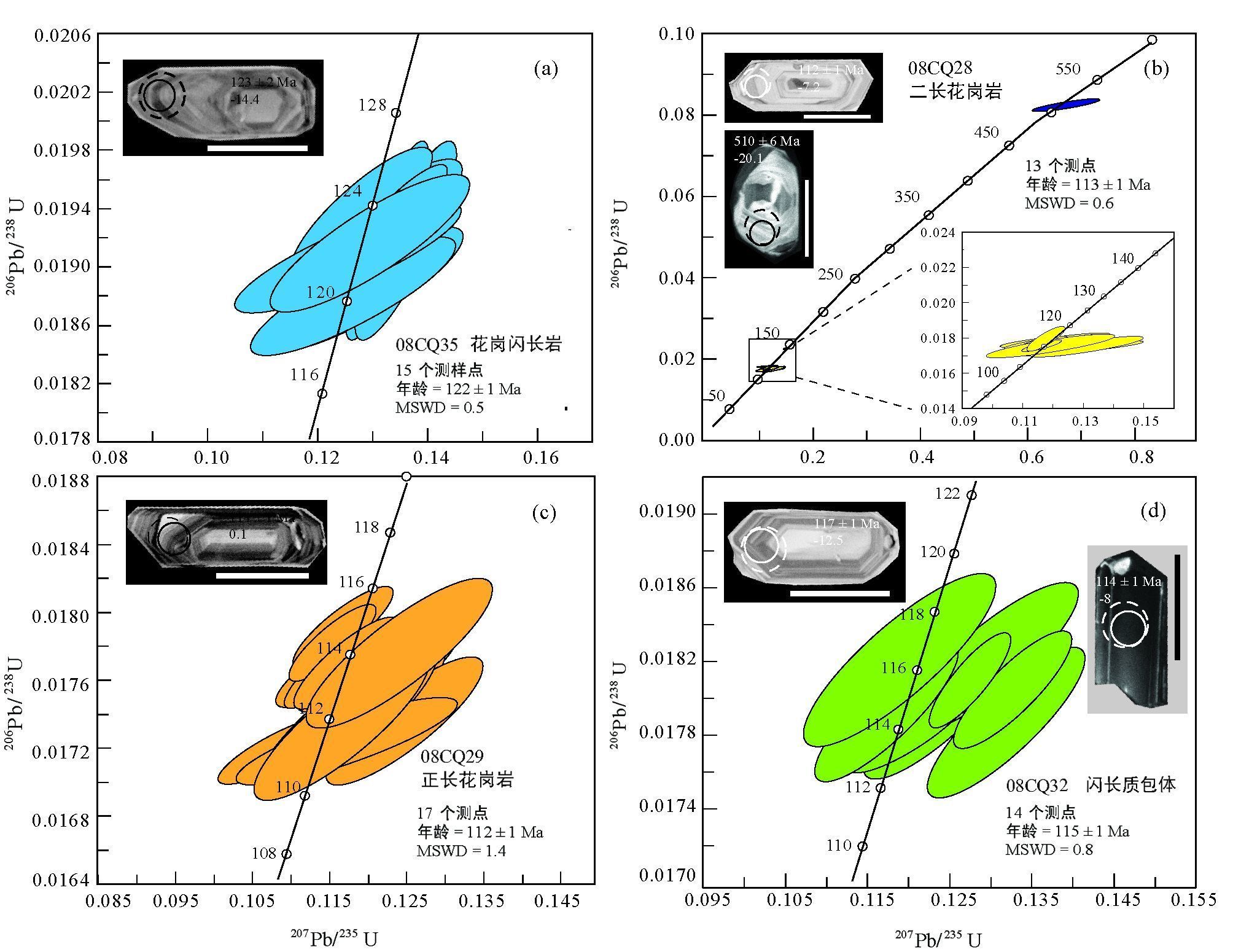
|
图 3 麦嘎岩基定年样品中的锆石CL图像和谐和图 Fig. 3 Cathodoluminescence (CL) images and concordia plots for zircons from the Maiga batholith |
|
|
表 1 中部拉萨地块措勤地区麦嘎岩基LA-ICP-MS锆石U-Pb同位素数据 Table 1 LA-ICP-MS zircon U-Pb analysis data of the Maiga batholith in Coqen region of the central Lhasa Terrane |
挑选新鲜样品在无污染环境下粉碎至200目。全岩主量元素分析是在西北大学 (西安) 大陆重力学国家重点实验室中使用XRF法在RIX-2100仪器上完成的,分析精度优于2%。微量元素分析是在中国地质大学 (武汉) 地质过程与矿产资源国家重点实验室中采用Agilent 7500 a等离子质谱仪 (ICP-MS) 测得,分析精度优于5%。在测试过程中,通过多次测试USGS参考样品 (BHVO-1,AGV-1和G-2) 来检测测试数据质量,分析条件及流程见Gao et al. (2002)。全岩Sr-Nd同位素含量测试是在中国地质大学 (武汉) 地质过程与矿产资源国家重点实验室中采用Finnigan MAT-261仪器完成,分析条件及流程见Liu et al. (2004)。测得的87Sr/86Sr和143Nd/144Nd比值分别采用86Sr/88Sr=0.1194和146Nd/144Nd=0.7219进行标准化。实验中Sr和Nd的空白值分别为<1ng和<50pg。标样BCR-2的143Nd/144Nd值为0.512612±6(2σ),标样NBS607的87Sr/86Sr值为1.19968±6(2σ)。样品全岩地球化学数据见表 2。
|
|
表 2 中部拉萨地块措勤地区麦嘎岩基全岩地球化学数据(主量元素wt%;微量元素×10-6) Table 2 Bulk-rock major element (wt%), trace element (×10-6) and Sr-Nd isotopic data of the Maiga batholith in Coqen region of the central Lhasa Terrane |
锆石原位锆石Hf同位素的测定是在西北大学 (西安) 大陆重力学国家重点实验室中,采用Nu Plasma HR MC-ICP-MS系统在锆石U-Pb定年分析的同一位置上进行的。测试的激光束直径为44μm,激光脉冲频率为8Hz。分析条件及流程见Yuan et al. (2008)。在分析过程中,使用91500、GJ-1和Monastery作为锆石标样检测分析数据。标样GJ-1的Hf同位素含量为0.282011(18(2σn, n=8),标样Monastery的Hf同位素含量为0.282739(14(2σn, n=8),与参考值在误差范围内 (2σ) 一致 (cf. Yuan et al., 2008)。εHf(t) 值是根据测点的锆石U-Pb年龄计算的,采用的176Lu衰变常数为1.867×10-11 year-1(Soderlund et al., 2004),球粒陨石176Hf/177Hf比值为0.282785,176Lu/177Hf比值为0.0336(Bouvier et al., 2008)。亏损地幔模式年龄 (tDM) 的计算参考现今亏损地幔176Hf/177Hf比值0.28325,176Lu/177Hf比值为0.0384(Griffin et al., 2000)。假设每颗锆石的母岩浆来自平均大陆地壳,采用176Lu/177Hf比值为0.015(Griffin et al., 2002) 计算锆石Hf同位素的地壳模式年龄 (tDMC)。选择不同衰变常数不会影响实验结果。锆石Lu-Hf同位素数据见表 3。
|
|
表 3 中部拉萨地块措勤地区麦嘎岩基锆石Hf同位素数据 Table 3 Zircon Hf isotopic data of the Maiga batholith in Coqen region of the central Lhasa Terrane |
对3件花岗质岩石样品及1件闪长质包体样品进行了锆石U-Pb定年及锆石原位Hf同位素分析。3件花岗质岩石样品中的锆石自形程度较好,呈长柱或棱柱形,长为50~200μm,长宽比为2:1~3:1。1件闪长质包体样品中的锆石多为自形棱柱状 (长为50~190μm),长宽比为1:1~2.5:1。对比花岗质岩石与闪长质包体的锆石CL图 (图 3),两者均可见明显的震荡环带结构,花岗岩类锆石Th/U比值为0.42~2.36,闪长质包体锆石Th/U比值为0.62~2.43(表 1),表明为它们均为岩浆锆石 (Hoskin and Black, 2000)。
1件二长花岗岩样品 (08CQ35) 中,除2个不谐和测点及1个继承锆石测点外,其它15个测点的206Pb/238U年龄变化于120~124Ma之间,加权平均年龄为122±1Ma (图 3a、表 1)。另外2件花岗质岩样品中,除4个不谐和测点及2个继承锆石测点外,其它30个测点给出的206Pb/238U年龄变化于110~115Ma之间,加权平均年龄分别为113±1Ma (08CQ28)(图 3b、表 1) 和112±1Ma (08CQ29)(图 3c、表 1)。这些数据表明,麦嘎岩基中的花岗质岩石很可能侵位于两期,分别为122±1Ma和113±2Ma。
1件闪长质包体样品中,除3个不谐和测点及1个继承锆石测点外,其它14个测点的206Pb/238U年龄变化于114~117Ma之间,加权平均年龄为115±1Ma (08CQ32)(图 3d、表 1),表明闪长质包体与113±2Ma的花岗质岩同期侵位。
4.2 全岩元素地球化学根据锆石U-Pb年龄及地球化学特征,本文将样品分为三组:第一组为122±1Ma花岗质岩石,包括2件样品 (另有2件重复样);第二组为113±2Ma寄主花岗质岩,包括5件样品 (另有1件重复样);第三组为113±2Ma的闪长质包体,包括4件样品。
第一组花岗质岩石 (122±1Ma) 的SiO2含量为74.20%~75.08%,Mg#为28~30(平均29.3),K2O含量为3.53%~3.74%,K2O/Na2O为1.10~1.18,A/CNK为1.04~1.05,刚玉分子数为0.63~0.78,在成分上属于弱过铝质高钾钙碱性花岗闪长岩及二长花岗岩 (图 4a,b, c、表 2)。第二组寄主花岗质岩石 (113±2Ma) 的SiO2含量变化范围较大,为69.19%~76.62%,Mg#为23~37(平均32.9),K2O含量为3.47%~5.03%,K2O/Na2O为1.09~1.57,A/CNK为0.97~1.06,刚玉分子数为0.08~1.08,在R2-R1图中投入花岗闪长岩、二长花岗岩及正长花岗岩的范围内 (图 4a),属于偏铝质-弱过铝质高钾钙碱性系列 (图 4b,c、表 2)。第三组闪长质包体 (113±2Ma) 的SiO2和K2O含量分别为55.44%~59.67%和1.05%~1.66%,Mg#为43~51(平均为46.5),K2O/N2O为0.28~0.50,A/CNK为0.74~0.87,岩石类型为闪长岩及二长闪长岩 (图 4a、表 2),属于偏铝质中-高钾钙碱性系列 (图 4b,c)。在选择性的地球化学散点图上 (图 5),随着随花岗质岩石样品的SiO2含量增加,Al2O3和TiO2含量降低 (图 5a,b),而A/CNK含量增加 (图 5c),表现出明显的线性趋势。样品的Al2O3/CaO-Na2O/CaO、SiO2/CaO-Na2O/CaO及FeOT-MgO (图 5d,e, f) 也表现出明显的正线性相关关系。
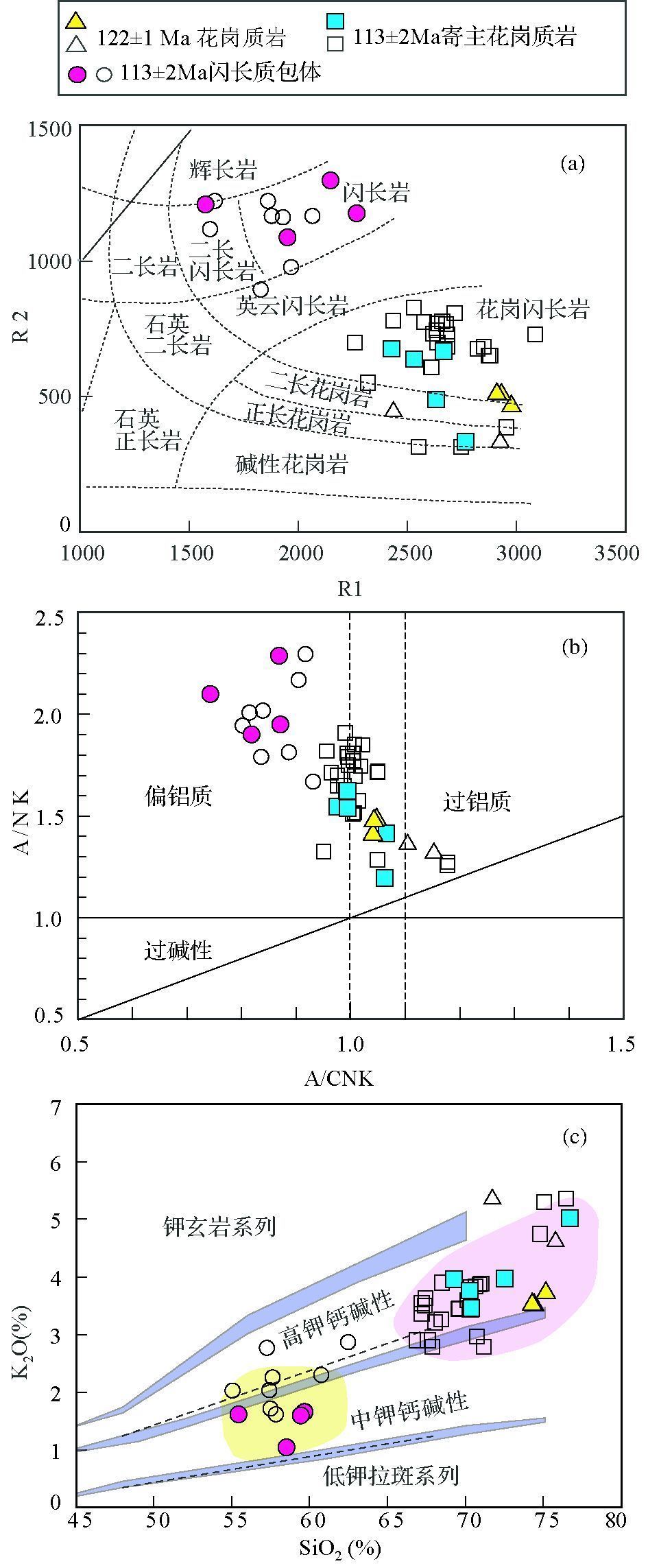
|
图 4 麦嘎岩基 (填充) 和中部拉萨地块其它地区 (未填充) 花岗质岩石与闪长质包体的地球化学图解 (a)-R2-R1岩石类型划分图 (De La Roche et al., 1980);(b)-A/NK-A/CNK散点图; (c)-K2O-SiO2岩石系列划分图 (Rollinson, 1993).中部拉萨地块其它数据引自Zhu et al., 2009b, 2011a; 张晓倩等, 2010; 张亮亮等, 2011; 朱弟成未刊数据 Fig. 4 Geochemical plots of granitoids and dioritic enclaves in the Maiga batholith (filled) and other areas of the central Lhasa Terrane (unfilled) |
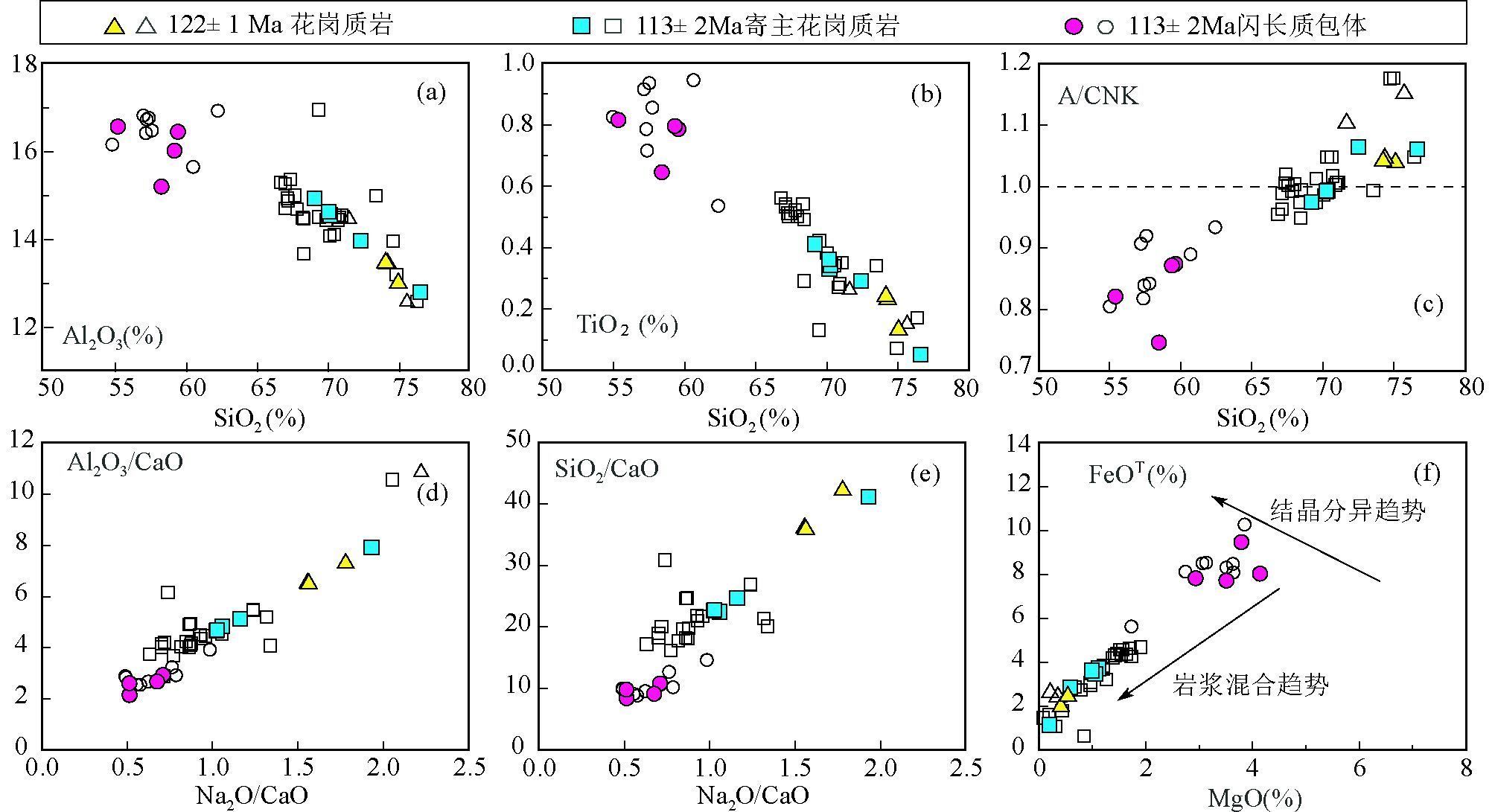
|
图 5 麦嘎岩基 (填充) 和中部拉萨地块其它地区 (未填充) 花岗质岩石与闪长质包体的选择性地球化学散点图 (图 5f据Zorpi et al., 1991) Fig. 5 Selected geochemical plots of granitoids and dioritic enclaves in the Maiga batholith (filled) and other areas of the central Lhasa Terrane (unfilled) (Fig. 5f after Zorpi et al., 1991) |
在原始地幔标准化微量元素蜘蛛图中 (图 6),第一组、第二组花岗质岩石与中部拉萨地块同期花岗质岩石表现相似的型式,均富集大离子亲石元素 (如Rb、Ba和K),亏损高场强元素 (如Nb、Ta和Ti)(图 6a)。两组花岗质岩石均具负δEu异常特征 (第一组: δEu=0.37~0.47;第二组: δEu=0.37~0.72)。第三组闪长质包体与中部拉萨地块同期中性岩石的原始地幔标准化微量元素蜘蛛图型式相似 (图 6b),也富集大离子亲石元素 (如Rb、Ba和K) 和亏损高场强元素 (如Nb、Ta和Ti),显示中等程度负δEu异常 (0.51~0.68)。

|
图 6 麦嘎岩基花岗质岩石 (a) 和闪长质包体 (b) 的微量元素蜘蛛图 (阴影部分为中部拉萨地块其它地区样品)(原始地幔标准化值及元素排序据Sun and McDonough, 1989) Fig. 6 Trace elemental spidergrams of the analyzed samples from granitoids (a) and dioritic enclaves (b) in the Maiga batholith (other areas of the central Lhasa Terrane showing with shade) (Data for normalization and plotting order are after Sun and McDonough, 1989) |
第一组花岗质岩石具有较高的 (87Sr/86Sr)i值 (0.7147) 及很低的全岩εNd(t) 值 (-12.0)(图 7),并具有古元古代二阶段Nd模式年龄 (tDM2=1.9Ga; 表 2)。第二组寄主花岗质岩石的Sr-Nd同位素组成变化较大,其中2件样品 (08CQ28和08CQ29) 的 (87Sr/86Sr)i分别为0.7156和0.7214,全岩εNd(t) 值分别为-12.1和-7.3,tDM2分别为1.9Ga和1.5Ga (表 2);其余4件样品的全岩εNd(t) 值 (-11.5~-9.5) 和二阶段Nd模式年龄 (tDM2=1.7~1.8Ga) 与前者相似,但其 (87Sr/86Sr)i值明显偏低 (0.7094~0.7095)(图 7)。第三组闪长质包体与第二组寄主花岗质岩石具有相似的Sr-Nd同位素组成,以变化范围大的 (87Sr/86Sr)i值 (0.7058~0.7105) 和负全岩εNd(t) 值 (-10.7~-9.8)(图 7、表 2) 为特征。
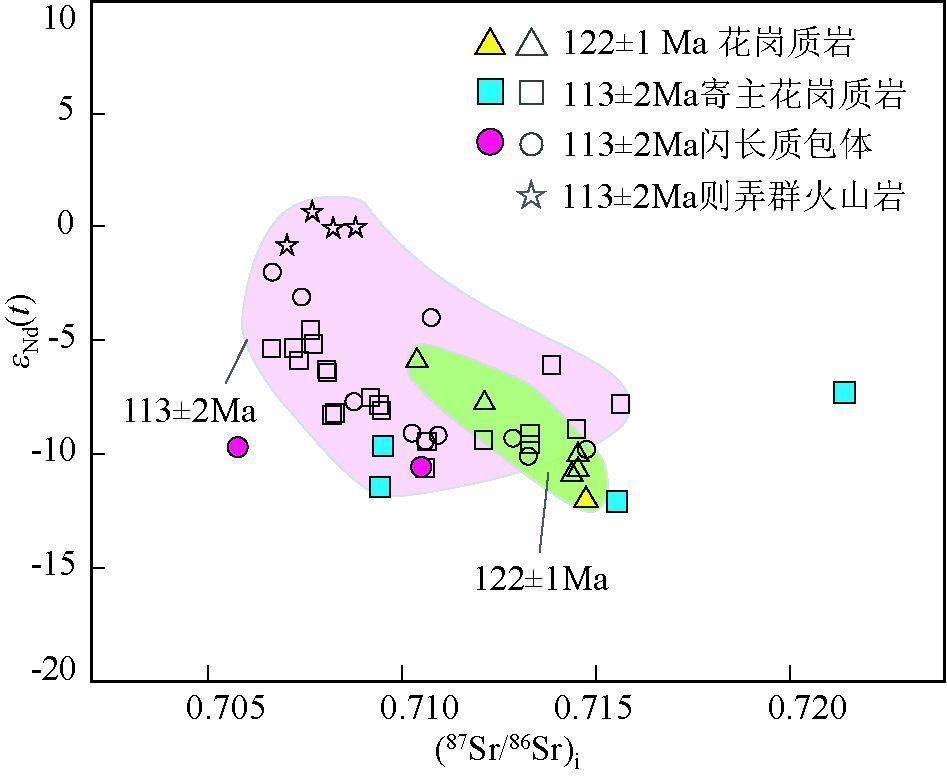
|
图 7 麦嘎岩基 (填充) 和中部拉萨地块其它地区 (未填充) 花岗质岩石与闪长质包体的εNd(t)-(87Sr/86Sr)i图 Fig. 7 εNd(t)-(87Sr/86Sr)i diagram of granitoids and dioritic enclaves in the Maiga batholith (filled) and other areas of the central Lhasa Terrane (unfilled) |
第一组花岗质岩石14个锆石测点的 (176Hf/177Hf)i值为0.28225~0.28238,εHf(t) 值为-15.7~-11.1(图 8a、表 3),地壳模式年龄 (tDMC) 为1.9~2.2Ga (图 8b、表 3),与其二阶段Nd模式年龄接近。第二组寄主花岗质岩石的29个锆石分析点的 (176Hf/177Hf)i值为0.28239~0.28270,εHf(t) 值变化范围大,除08CQ28 13锆石测点的εHf(t) 为-11.1外,其余锆石εHf(t) 集中于-7.2~0.1(图 8a、表 3);08CQ28 13地壳模式年龄 (tDMC) 为1.9Ga,其余锆石地壳模式年龄 (tDMC) 为1.2~1.6Ga (图 8b、表 3),与其二阶段Nd模式年龄相近。与第一组花岗质岩石相比,第二组寄主花岗质岩石的εHf(t) 值更高,地壳模式年龄更低 (图 8a,b, c)。第三组闪长质包体14个锆石分析点的 (176Hf/177Hf)i值为0.28231~0.28254,εHf(t) 值比第二组寄主花岗岩小,除08CQ32 10为-5.6,其余锆石εHf(t) 集中在-14.0~-8.0之间 (图 8a、表 3);08CQ32 10地幔模式年龄 (tDM) 为1.0Ga,其余锆石地幔模式年龄 (tDM) 为1.1~1.3Ga (表 3)。
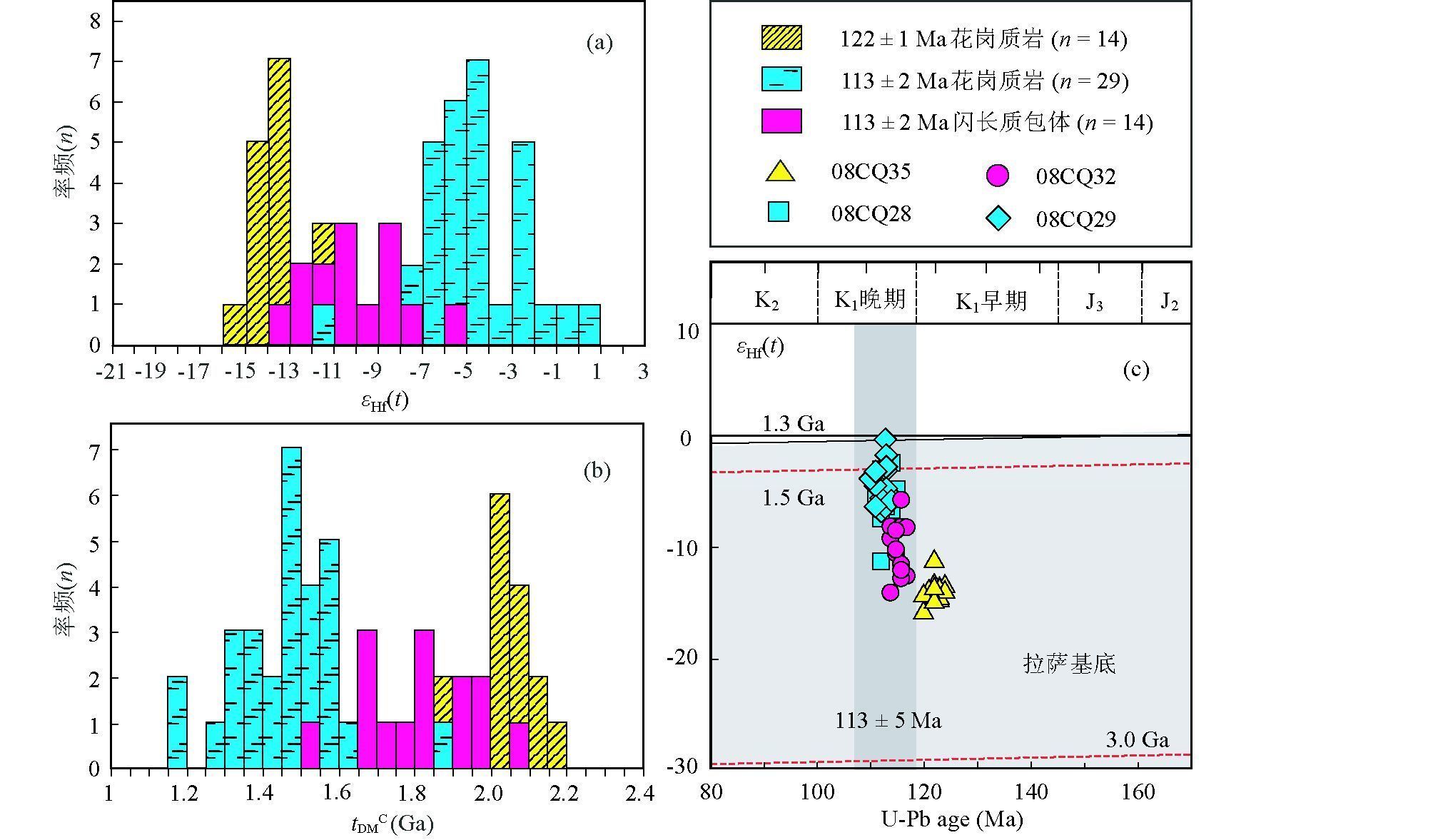
|
图 8 麦嘎岩基锆石εHf(t) 值 (a)、锆石Hf同位素地壳模式年龄 (tDMC) 直方图 (b) 和εHf(t)-年龄图解 (c, 据Zhu et al., 2011a) Fig. 8 Histograms of zircon εHf(t) (a), zircon Hf isotope crust model age (tDMC) (b) and εHf(t)-age (Ma) (c, after Zhu et al., 2011a) diagram for the Maiga batholith |
本文在中部拉萨地块西部麦嘎岩基中获得的高质量锆石U-Pb年代学数据表明,麦嘎岩体的侵位时代可分为两期,包括122±1Ma的花岗质岩石、113±2Ma的寄主花岗质岩和同期闪长质包体。在中部拉萨地块,革吉县南 (约126Ma; Zhu et al., 2009b)、雄巴 (116~129Ma; Zhu et al., 2009b)、措勤西部和北部 (125~130Ma; 刘登忠等, 2003; 朱弟成等, 2008c; Zhu et al., 2009b, 2011a)、当惹雍错西岸 (约124Ma; 谢国刚等, 2002①) 和门巴洞中拉 (约117Ma; 费光春等, 2010) 等地,以及北部拉萨地块南缘桑巴地区 (约120Ma; 和钟铧等, 2006; 刘美华, 2011),均发现了与麦嘎岩基早期岩浆活动 (122±1Ma) 同期的岩浆作用记录 (图 1c)。
已有资料表明,与麦嘎岩基113±2Ma同期的岩浆作用也同样广泛分布于中部拉萨地块 (图 1c)。例如在措勤县北部 (约107Ma; 周长勇等, 2008; Zhu et al., 2009b) 和南东部 (110~120Ma; 朱弟成等, 2008c; Zhu et al., 2009b; 刘伟等, 2010; 张晓倩等, 2010)、申扎 (113±3Ma; Zhu et al., 2009b, 2011a; 张亮亮等, 2011) 和北部拉萨地块南缘桑巴 (约110Ma; 刘美华, 2011) 等地发现的同期岩浆岩记录。值得注意的是,这一时期的镁铁质岩浆作用明显增强,如已有研究先后在措勤 (约107Ma; 刘登忠等, 2003)、达雄 (约106Ma; 刘登忠等, 2003) 和申扎 (约111Ma, 康志强等, 2008; 张亮亮等, 2011) 等地报道的镁铁质岩浆作用记录等。
①谢国刚, 邹爱建, 袁建芽等. 2002.中华人民共和国1:25万区域地质调查报告措麦区幅
综上所述,已有年代学数据表明中部拉萨地块在早白垩世经历了大规模岩浆活动事件,即从中部拉萨地块的西部至东部,均发育与麦嘎岩基早期 (约122Ma) 和晚期 (约113Ma) 岩浆活动同期的岩浆事件 (图 1c),并且随时间演化,幔源岩浆作用 (包括辉长岩、石英闪长玢岩脉和闪长质包体等) 的强度明显增加。
5.2 花岗岩类的成因类型本文获得的第一组花岗质岩石 (122±1Ma) 样品为弱过铝质,这些样品与中部拉萨地块同期样品的P2O5含量随SiO2含量增加而降低 (图 9a),与I型花岗岩的演化趋势一致 (Chappell, 1999; Wu et al., 2003; Li et al., 2007; 朱弟成等, 2009d)。122±1Ma花岗质岩的Zr、Nb、Ce和Y含量较低,在FeOT/MgO-(Zr+Nb+Ce+Y) 散点图 (图 9b) 中落入高分异与未分异花岗岩的界线附近,在 (Al2O3+CaO)/(FeOT+Na2O+K2O)-100(MgO+FeOT+TiO2)/SiO2(Sylvester, 1989) 中 (图 9c),显示普通钙碱性岩石特征。因此,中部拉萨地块约122Ma的花岗质岩石可能为经历了明显的磷灰石、磁铁矿和/或钛铁矿等副矿物、不明显的长石类造岩矿物分离结晶作用的I型花岗质岩石。这些花岗质岩中出现的普通角闪石 (图 2c),也证实它们属于I型花岗岩类 (吴福元等, 2007)。

|
图 9 麦嘎岩基 (填充) 和中部拉萨地块其它地区 (未填充) 花岗质岩石与闪长质包体的岩石成因判别图解 (a)-P2O5-SiO2散点图;(b)-FeOT/MgO-(Zr+Nb+Ce+Y) 散点图 (Whalen et al., 1987);(c)-(Al2O3+CaO)/(FeOT+Na2O+K2O)-100(MgO+FeOT+TiO2)/ SiO2散点图 (Eyal et al., 2004) Fig. 9 Distrimination diagrams of petrogenetic types for granitoids and dioritic enclaves in the Maiga batholith (filled) and other areas of the central Lhasa Terrane (unfilled) |
第二组寄主花岗质岩石样品 (113±2Ma) 为偏铝质-过铝质,可见普通角闪石 (图 2d)。本文获得的样品和中部拉萨地块其它地区的同期花岗质岩石,均表现出与第一组花岗质岩石样品类似的I型花岗岩演化趋势 (图 9a),属于未分异的普通钙碱性I型花岗质岩石 (图 9b,c)。
5.3 岩浆源区已有研究认为,I型花岗岩由壳内中基性火成岩或变质岩部分熔融而来 (Chappell and Stephens, 1988; 吴福元等, 2007; 张旗等, 2008),或者地壳重融过程中,幔源贡献量增加形成 (Kemp et al., 2007; Collins and Richards, 2008; 李献华等, 2009; Zhu et al., 2009b; 朱弟成等, 2009d)。本文同位素数据显示,麦嘎岩基122±1Ma花岗质岩以很负的全岩εNd(t)(-12.0) 和锆石εHf(t)(-15.7~-11.1) 为特征,具有古老的二阶段Nd模式年龄 (1.9Ga) 及锆石Hf同位素地壳模式年龄 (1.9~2.2Ga)(表 2, 、表 3)。因此,这套具有偏铝质特征的I型花岗岩,可能主要来源于古老下地壳物质的重熔。
和第一组花岗质岩石相比,第二组寄主花岗质岩的全岩εNd(t) 值 (-12.1~-7.3) 和锆石εHf(t) 值 (集中于-7.2~0.1) 较高,并且变化范围更大,对应于更年轻的和变化的二阶段Nd模式年龄 (1.5~1.9Ga) 及锆石Hf同位素地壳模式年龄 (集中于1.2~1.6Ga)(表 2、表 3)。这些特征表明第二组寄主花岗质岩主要来源于古老下地壳物质的部分熔融,但却包含更多的幔源物质。
第三组闪长质包体样品显示富集轻稀土元素和大离子亲石元素 (如Rb、Ba和K)、亏损高场强元素 (如Nb、Ta和Ti)(图 6b) 等地球化学特征,这表明其源区可能是古老下地壳或受俯冲板片流体或熔体交代的富集岩石圈地幔。这些闪长质包体以变化范围大的 (87Sr/86Sr)i值 (0.7058~0.7110)、负的全岩εNd(t) 值 (-10.7~-9.2) 和负的锆石εHf(t) 值 (集中于-14.0~-8.0)、古老的地幔模式年龄 (tDM)(集中于1.1~1.3Ga) 为特征,这种情况与辽东半岛 (Yang et al., 2004) 和华北地区 (Sun et al., 2010) 花岗闪长岩中出露的包体相似,指示它们可能来源于古老的富集岩石圈地幔物质的部分熔融或亏损地幔物质经历强烈地壳混染作用的结果。
本文获得的数据表明,在麦嘎岩基中,从122±1Ma到113±2Ma,全岩εNd(t) 和锆石εHf(t) 值增高,锆石εHf(t) 值变化范围增大 (图 7、图 8a,c),暗示幔源组分有随时间增加的趋势。这一现象与在中部拉萨地块其它地区的已有研究 (Zhu et al., 2009b, 2011a) 一致,表明在大约113Ma幔源物质的显著增加在中部拉萨地块是一个共同现象,暗示整个中部拉萨地块的早白垩世岩浆岩可能具有类似的岩石成因。
5.4 岩石成因已有研究认为,花岗质岩石中发育的闪长质包体通常有四种成因解释:(1) 围岩捕掳体;(2) 源区固态难熔残余物;(3) 同源或同生析离体、堆积体;(4) 不同性质岩浆混合时的残留体 (Holden et al., 1987; Chappell and White, 1991; 朱金初等, 2006; 陈卫锋等, 2007; Guan et al., 2012)。虽然这四种解释均有可能符合本文中闪长质包体的成因机制,但更多的证据表明,本文中闪长质包体成因的最合理解释为镁铁质岩浆与长英质岩浆不同比例混合的残留体。
(1) 麦嘎岩基中的闪长质包体具有典型的岩浆结构,边部可见浅色长英质晕圈 (图 2a),为基性岩浆与花岗岩浆化学交换的产物 (莫宣学等, 2007);闪长质包体中出露钾长石巨晶形成的不平衡矿物组成 (图 2b),指示镁铁质岩浆与长英质岩浆在冷却结晶之前,发生了物质交换 (Neves and Vauchez, 1995; Silva et al., 2000; 莫宣学等, 2007; Kaygusuz and Aydincakir, 2009; Karsli et al., 2007, 2010)。显微镜下观察,寄主花岗质岩石中可观察到斜长石的跳跃环带结构 (图 2e),暗示斜长石结晶环境的扰动,可能与多期次岩浆混合有关 (覃峰等, 2006; Sun et al., 2010);闪长质包体中可观察到由快速冷凝结晶形成的针状磷灰石 (图 2f),其为不同温差的岩浆混合时,高温岩浆快速冷却的产物 (Kaygusuz and Aydincakir, 2009; Karsli et al., 2007, 2010; Sun et al., 2010)。
(2) 闪长质包体与寄主花岗质岩石为同期侵位 (113±2Ma),排除了闪长质包体为源区残留物或围岩捕掳体的可能 (Didier, 1984; Vernon, 1990; Kaygusuz and Aydincakir, 2009; Karsli et al., 2007, 2010)。
(3) 在多元素同分母散点图 (图 5d,e) 及FeOT-MgO散点图 (图 5f) 上,显示明显的正相关线性关系。对基性岩石而言,这可能指示了镁铁质矿物的分离结晶,但对花岗岩类岩石而言,这种趋势常解释为岩浆混合作用的结果 (Zorpi et al., 1991; Karsli et al., 2007; Kaygusuz and Aydincakir, 2009; 张招崇等, 2009)。
(4) 由于锆石的Lu-Hf同位素体系具有很高的封闭温度,锆石Hf同位素比值不会随后期部分熔融或分离结晶而变化,因此锆石εHf(t) 值代表了岩浆源区的成分特征,不均一的锆石Hf同位素特征很可能指示了一个开放体系,与具有不同放射性成因Hf同位素含量的几种岩浆混合有关 (Kemp et al., 2007; 朱弟成等, 2009d; Zhu et al., 2009a, b, c, 2011a; Ravikant et al., 2011)。麦嘎岩基中同期侵位于113Ma的寄主花岗质岩石和闪长质包体均具有变化范围大的εHf(t) 值 (图 8a,c、表 3),这很可能是两种或两种以上不同性质岩浆混合作用的结果。
5.5 意义大部分学者将拉萨地块中北部地区的白垩纪岩浆作用,解释为雅鲁藏布新特提斯洋壳岩石圈北向低角度俯冲和随后的板片回转的产物 (Coulon et al., 1986; Pearce and Mei, 1988; Zhang et al., 2004; Kapp et al., 2007),但近年来的大量野外调研和岩浆岩岩石学、地球化学研究表明,这种低角度北向俯冲无法解释目前在拉萨地块南部发现的大规模早白垩世岩浆活动 (朱弟成等, 2008c; Ji et al., 2009; Zhu et al., 2009a, b; Wu et al., 2010)。相反,越来越多的证据表明,拉萨地块中北部地区的大规模早白垩世岩浆活动,很可能与班公湖-怒江洋洋壳岩石圈的南向俯冲和随后的板片断离事件有关 (潘桂棠等, 2006; 朱弟成等, 2006; 康志强等, 2008, 2010; 张晓倩等, 2010; 张亮亮等, 2011; Zhu et al., 2009b, 2011a)。本文获得的数据进一步证实,中部拉萨地块早白垩世早中期以酸性岩浆活动为特色,到早白垩世晚期发生了幔源物质显著增加的现象,这种在早白垩世晚期发生的岩浆成分的突然变化,必定和特定的地球动力学背景的改变密切相关。本文赞成南向俯冲的班公湖-怒江洋壳岩石圈在113Ma左右发生的板片断离事件 (Zhu et al., 2009b, 2011a),是解释麦嘎岩基和中部拉萨地块其它地区观察到的幔源物质显著增加这一现象的最合理解释。
班公湖-怒江洋洋壳岩石圈在115Ma以前仍然在发生南向俯冲 (朱弟成等, 2008b; Zhu et al., 2009b, 2011a),受来自俯冲板片流体或熔体的影响,位于中部拉萨地块的古老下地壳发生部分熔融,形成麦嘎岩基和中部拉萨地块其它地区观察到的早白垩世早期 (约122Ma) 岩浆活动 (图 10a)。随着时间推移,班公湖-怒江洋壳板片俯冲到一定深度,由于重力作用发生板片回转进而断离 (break off)(约113Ma, Zhu et al., 2009b, 2011a),热的软流圈物质沿板片构造窗上涌,为上覆的中部拉萨地块富集岩石圈地幔及古老下地壳提供热源,使两者发生减压和升温熔融 (Karsli et al., 2007),发生岩浆混合事件,形成麦嘎岩基和中部拉萨地块早白垩世晚期 (约113Ma) 大规模带状岩浆活动 (图 10b)。

|
图 10 中部拉萨地块早白垩世时期构造岩浆演化示意图 (据Zhu et al., 2011a修改) Fig. 10 Schematic illustration of the tectonomagmatic evolution of the central Lhasa Terrane during the Early Cretaceous time (modified after Zhu et al., 2011a) |
一般来说,岩浆混合作用在地壳深部更容易发生,特别是在下地壳和壳-幔边界一带 (Pitcher, 1997),如爱尔兰加里东Galway岩基 (Desouky et al., 1996) 也形成于与麦嘎岩基类似的地球动力学过程。中部拉萨地块在早白垩世晚期发生的强烈壳幔作用事件,不仅产生了大规模岩浆作用,而且还伴随着铁、铅、锌等多金属矿床形成 (曹圣华等, 2007; 吴旭玲等, 2007①; 袁建芽等, 2005②, 2008),幔源物质的加入很可能是发生成矿作用的必要条件 (Oyarzun et al., 2003)。因此,对中部拉萨地块早白垩世强烈的壳-幔作用记录开展研究,有望成为中部拉萨地块早白垩世成矿作用研究的一个新的窗口。
①吴旭铃, 胡为正, 黄建村等. 2007.西藏尼雄周边地区富铁矿评价地质报告
②袁健芽, 吴旭铃, 胡为正等. 2005.西藏措勤-昂仁地区铁铜矿评价工作简报
6 结论(1) 麦嘎岩基主要侵位于两期 (约122Ma和约113Ma),前者以花岗岩质岩浆活动特色,后者以花岗质和闪长质岩浆活动为特征。这两期岩浆事件与中部拉萨地块其它地区类似。
(2) 麦嘎岩基122±1Ma与113±2Ma花岗类岩均属于未分异的普通钙碱性I型花岗岩,其中约122Ma的花岗质岩石以弱过铝质高钾钙碱性、高初始Sr同位素、很负的全岩εNd(t) 和锆石εHf(t) 及古老的tDMC为特征,很可能来源于古老下地壳物质的重熔;约113Ma的寄主花岗岩类属偏铝质-弱过铝质高钾钙碱性系列,以变化的初始Sr同位素、较负全岩εNd(t) 和较负且变化范围大的锆石εHf(t) 及古老的tDMC为特征,主要源于古老下地壳物质的部分熔融,与约122Ma花岗质岩石相比,包含更多的幔源物质;约113Ma的闪长质包体为偏铝质中-高钾钙碱性系列,以变化范围大的初始Sr同位素、负的全岩εNd(t) 和锆石εHf(t) 为特征,可能是古老富集岩石圈地幔物质部分熔融的产物或亏损地幔物质经历强烈地壳混染作用的结果。
(3) 在目前已有资料条件下,本文暂时将麦嘎岩基约113Ma的寄主花岗岩类及同期闪长质包体解释为镁铁质岩浆与长英质岩浆发生不同程度岩浆混合作用的结果,整个中部拉萨地块的此时期岩浆岩可能具有类似的岩石成因。
(4) 班公湖-怒江洋洋壳岩石圈南向俯冲,并在大约113Ma发生的板片断离事件,是麦嘎岩基和中部拉萨地块其它地区观察到的约113Ma幔源物质显著增加现象的一种最合理解释。
| [] | Andersen T. 2002. Correction of common lead in U-Pb analyses that do not report 204Pb. Chemical Geology, 192: 59–79. DOI:10.1016/S0009-2541(02)00195-X |
| [] | Bouvier A, Vervoort JD and Patchett PJ. 2008. The Lu-Hf and Sm-Nd isotopic composition of CHUR: Constraints from unequilibrated chondrites and implications for the bulk composition of terrestrial planets. Earth and Planetary Science Letters, 273: 48–57. DOI:10.1016/j.epsl.2008.06.010 |
| [] | Cao SH, Li DW, Yu ZZ, Yuan JY, Wu XL and Hu WZ. 2007. Metallogenic and geological characteristics of the Nixiong superlarge magnetite deposit in Gangdese, Tibet. Geotectonica et Metallogenia, 31(3): 328–335. |
| [] | Chappell BW and Stephens WE. 1988. Origin of infracrustal (I-type) granite magmas. Trans. R. Soc. Edinburgh Earth Sci., 79(2-3): 71–86. DOI:10.1017/S0263593300014139 |
| [] | Chappell BW and White ARJ. 1991. Restite enclaves and the restite model. In: Didier J and Barbarin B (eds). Enclaves and Granite Petrology. Amsterdam: Elsevier, 375-381 |
| [] | Chappell BW. 1999. Aluminium saturation in I-and S-type granites and the characterization of fractionated haplogranites. Lithos, 46: 535–551. DOI:10.1016/S0024-4937(98)00086-3 |
| [] | Chen WF, Chen PR, Huang HY, Ding X and Sun T. 2007. Chronological and geochemical studies of granite and enclave in Baimashan pluton, Hunan. Science in China (Series D), 50(11): 1606–1627. DOI:10.1007/s11430-007-0073-1 |
| [] | Chiu HY, Chung SL, Wu FY, Liu DY, Liang YH, Lin YJ, Iizuka Y, Xie LW, Wang YB and Chu MF. 2009. Zircon U-Pb and Hf isotope constraints from eastern Transhimalayan batholiths on the precollisional magmatic and tectonic evolution in southern Tibet. Tectonophysics, 477: 3–19. DOI:10.1016/j.tecto.2009.02.034 |
| [] | Collins WJ and Richards SW. 2008. Geodynamic significance of S-type granites in circum-Pacific orogens. Geology, 36: 559–562. DOI:10.1130/G24658A.1 |
| [] | Copeland P, Harrison TM, Pan Y, Kidd WSF, Roden M and Zhang YQ. 1995. Thermal evolution of the Gangdese batholith, southern Tibet: A history of episodic unroofing. Tectonics, 14: 223–236. DOI:10.1029/94TC01676 |
| [] | Coulon C, Maluski H, Bollinger C and Wang S. 1986. Mesozoic and Cenozoic volcanic rocks from central and southern Tibet: 39Ar/40Ar dating, petrological characteristics and geodynamical significance. Earth and Planetary Science Letters, 79: 281–302. DOI:10.1016/0012-821X(86)90186-X |
| [] | De La Roche H, Leterrier J, Grande Claude P and Marchal M. 1980. A classification of volcanic and plutonic rocks using R1-R2 diagrams and major element analysis: Its relationships and current nomenclature. Chemical Geology, 29: 183–210. DOI:10.1016/0009-2541(80)90020-0 |
| [] | Deng J, Yang LQ and Wang CM. 2011. Research advances of superimposed orogenesis and metallogenesis in the Sanjiang Tethys. Acta Petrologica Sinica, 27(9): 2501–2509. |
| [] | Desouky MD, Feely M and Mortr P. 1996. Diorite-granite magma mingling and mixing along the axis of Galway Granite batholith, Ireland. Journal of the Society London, 153: 361–374. DOI:10.1144/gsjgs.153.3.0361 |
| [] | Didier J. 1984. The Problem of Enclaves in Granitic Rocks: A Review of Recent Ideas on Their Origin. Beijing: Science Press: 137-144. |
| [] | Eyal M, Litvinovsky BA, Katzir Y and Zanvilevich AN. 2004. The Pan-African high-K calc-alkaline peraluminous Elat granite from southern Israel: Geology, geochemistry and petrogenesis. Journal of African Earth Sciences, 40: 115–136. DOI:10.1016/j.jafrearsci.2004.11.005 |
| [] | Fei GC, Wen CQ, Wang CS, Wu PY, Wen Q and Zhou X. 2010. Zircon SHRIMP U-Pb age and its geological significance in Dongzhongla allgovite, Mozhugongka area, eastern segment of Gangdise, Tibet, China. Geological Bulletin of China, 29(8): 1138–1142. |
| [] | Gao S, Liu XM, Yuan HL, Hattendorf B, Gunther D, Chen L and Hu SH. 2002. Determination of forty-two major and trace elements in USGS and NIST SRM glasses by laser ablation-inductively coupled plasma-mass spectrometry. Geostandards Newsletter-Journal of Geostandards and Geoanalysis, 26: 191–196. |
| [] | Griffin WL, Pearson NJ, Belousova E, Jackson SE, van Achterbergh E, O'Reilly SY and Shee SR. 2000. The Hf isotope composition of cratonic mantle: LAM-MC-ICPMS analysis of zircon megacrysts in kimberlites. Geochimica et Cosmochimica Acta, 64: 133–147. DOI:10.1016/S0016-7037(99)00343-9 |
| [] | Griffin WL, Wang X, Jackson SE, Pearson NJ, O'Reilly SY, Xu X and Zhou X. 2002. Zircon chemistry and magma mixing, SE China: In-situ analysis of Hf isotopes, Tonglu and Pingtan igneous complexes. Lithos, 61: 237–269. DOI:10.1016/S0024-4937(02)00082-8 |
| [] | Guan Q, Zhu DC, Zhao ZD, Dong GC, Zhang LL, Li XW, Liu M, Mo XX, Liu YS and Yuan HL. 2012. Crustal thickening prior to 38Ma in southern Tibet: Evidence from lower crust-derived adakitic magmatism in the Gangdese Batholith. Gondwana Research, 21: 88–99. DOI:10.1016/j.gr.2011.07.004 |
| [] | Harris NBW, Xu RH, Lewis CL, Hawkesworth CJ and Zhang YQ. 1988. Isotope geochemistry of the 1985 Tibet Geotraverse: Lhasa to Golmud. Philosophical Transactions of the Royal Society of London. Series A, Mathematical and Physical Sciences, 327(1594): 263–285. DOI:10.1098/rsta.1988.0129 |
| [] | He ZH, Yang DM and Wang TW. 2006. The determination of Early Cretaceous post-collision granitoids in Sangba area of Gangdese tectonic belt and its tectonic significance. Acta Petrologica et Mineralogica, 25(3): 185–193. |
| [] | Holden P, Halliday AN and Stephens WE. 1987. Neodymium and strontium isotope content of microdiorite enclaves points to mantle input to granitoids production. Nature, 330: 53–56. DOI:10.1038/330053a0 |
| [] | Hoskin PWO and Black LP. 2000. Metamorphic zircon formation by solid-state recrystallization of protolith igneous zircon. Journal of Metamorphic Geology, 18: 423–439. |
| [] | Hu DG, Wu ZH, Jiang W, Shi YR, Ye PS and Liu QS. 2005. SHRIMP zircon U-Pb age and Nd isotopic study on the Nyainqêntanglha Group in Tibet. Science in China, 48: 1377–1386. DOI:10.1360/04yd0183 |
| [] | Jackson SE, Pearson NJ, Griffin WL and Belousova EA. 2004. The application of laser ablation-inductively coupled plasma-mass spectrometry to in situ U-Pb zircon geochronology. Chemical Geology, 211: 47–69. DOI:10.1016/j.chemgeo.2004.06.017 |
| [] | Ji WQ, Wu FY, Chung SL, Li JX and Liu CZ. 2009. Zircon U-Pb chronology and Hf isotopic constraints on the petrogenesis of Gangdese batholiths, southern Tibet. Chemical Geology, 262: 229–245. DOI:10.1016/j.chemgeo.2009.01.020 |
| [] | Kang ZQ, Xu JF, Dong YH and Wang BQ. 2008. Cretaceous volcanic rocks of Zenong Group in north-middle Lhasa block: Products of southward subducting of the Slainajap ocean?. Acta Petrologica Sinica, 24(2): 303–314. |
| [] | Kang ZQ, Xu JF, Wang BD and Chen JL. 2010. Qushenla Formation volcanic rocks in north Lhasa block: Products of Bangong Co-Nujiang Tethyp's southward subduction. Acta Petrologica Sinica, 26(10): 3106–3116. |
| [] | Kapp P, Yin A, Harrison TM and Ding L. 2005. Cretaceous-Tertiary shortening, basin development, and volcanism in central Tibet. Geological Society of America Bulletin, 117: 865–878. DOI:10.1130/B25595 |
| [] | Kapp P, DeCelles PG, Gehrels GE, Heizler M and Ding L. 2007. Geological records of the Lhasa-Qiangtang and Indo-Asian collisions in the Nima area of central Tibet. GSA Bulletin, 119: 917–932. DOI:10.1130/B26033.1 |
| [] | Karsli O, Chen B, Aydin F and Sen C. 2007. Geochemical and Sr-Nd-Pb isotopic compositions of the Eocene Dölek and Sariçiçek Plutons, Eastern Turkey: Implications for magma interaction in the genesis of high-K calc-alkaline granitoids in a post-collision extensional setting. Lithos, 98: 67–96. DOI:10.1016/j.lithos.2007.03.005 |
| [] | Karsli O, Dokuz A, Uysal I, Aydin F, Chen B, Kandemir R and Wijbrans J. 2010. Relative contributions of crust and mantle to generation of Campanian high-K calc-alkaline I-type granitoids in a subduction setting, with special reference to the Harsit Pluton, Eastern Turkey. Contrib. Mineral. Petrol., 160: 467–487. DOI:10.1007/s00410-010-0489-z |
| [] | Kaygusuz A and Aydincakir K. 2009. Mineralogy, whole-rock and Sr-Nd isotope geochemistry of mafic microgranular enclaves in Cretaceous Dagbasi granitoids, Eastern Pontides, NE Turkey: Evidence of magma mixing, mingling and chemical equilibration. Chemie der Erde, 69: 247–277. DOI:10.1016/j.chemer.2008.08.002 |
| [] | Kemp AIS, Hawkesworth CJ, Foster GL, Paterson BA, Woodhead JD, Hergt JM, Gray CM and Whitehouse MJ. 2007. Magmatic and crustal differentiation history of granitic rocks from Hf-O isotopes in zircon. Science, 16: 980–983. |
| [] | Li XH, Li ZX, Li WX, Liu Y, Yuan C, Wei GJ and Qi CS. 2007. U-Pb zircon, geochemical and Sr-Nd-Hf isotopic constraints on age and origin of Jurassic I-and A-type granites from central Guangdong, SE China: A major igneous event in response to foundering of a subducted flat-slab?. Lithos, 96: 186–204. DOI:10.1016/j.lithos.2006.09.018 |
| [] | Li XH, Li WX, Wang XC, Li QL, Liu Y and Tang GQ. 2009. Role of mantle-derived magma in genesis of early Yanshanian granites in the Nanling Range, South China: In situ zircon Hf-O isotopic constraints. Science in China (Series D), 39(7): 872–887. |
| [] | Liu MH. 2011. Geochronology and geochemistry of the Samba granitoids in north Gangdese. Master Degree Thesis. Beijing: China University of Geosciences (in Chinese with English summary) |
| [] | Liu W, Li FQ, Yuan SH, Zhang WP, Zhuo JW, Wang BD and Tang WQ. 2010. Volcanic rocks source of Zenong Group in the Coqen area of Tibet: Geochemistry and Sr-Nd isotopic limitation. Acta Petrologica et Mineralogica, 29(4): 367–376. |
| [] | Liu YS, Gao S, Yuan HL, Zhou L, Liu XM, Wang XC, Hu ZC and Wang LS. 2004. U-Pb zircon ages and Nd, Sr, and Pb isotopes of lower crustal xenoliths from North China Craton: Insights on evolution of lower continental crust. Chemical Geology, 211: 87–109. DOI:10.1016/j.chemgeo.2004.06.023 |
| [] | Liu YS, Gao S, Gao CG, Zong KQ, Hu ZC and Ling WL. 2010. Garnet-rich granulite xenoliths from the Hannuoba basalts, North China: Petrogenesis and implications for the Mesozoic crust-mantle interaction. Journal of Earth Science, 21(5): 669–691. DOI:10.1007/s12583-010-0125-x |
| [] | Ludwig KR. 2003. Isoplot v. 3.0: A geochronological toolkit for Microsoft Excel. Berkeley Geochronology Center. Special Publication, 4: 1–70. |
| [] | Mo XX, Luo ZH, Deng JF, Yu XH, Liu DC, Chen HW, Yuan WM and Liu YH. 2007. Granitoids and crustal growth in the East-Kunlun Orogenic Belt. Geological Journal of China Universities, 13(3): 403–414. |
| [] | Mo XX, Niu YL, Dong GC, Zhao ZD, Hou ZQ, Zhou S and Ke S. 2008. Contribution of syncollisional felsic magmatism to continental crust growth: A case study of the Paleogene Linzizong volcanic succession in southern Tibet. Chemical Geology, 250: 49–68. DOI:10.1016/j.chemgeo.2008.02.003 |
| [] | Neves SP and Vauchez A. 1995. Successive mixing and mingling of magmas in a plutonic complex of Northeast Brazil. Lithos, 34: 275–299. DOI:10.1016/0024-4937(94)00012-Q |
| [] | Oyarzun R, Oyarzun J, Menard JJ and Lillo J. 2003. The Cretaceous iron belt of northern Chile role of oceanic plates, a superplume event, and a major shear zone. Mineralium Deposita, 38: 640–646. DOI:10.1007/s00126-003-0359-y |
| [] | Pan GT, Mo XX, Hou ZQ, Zhu DC, Wang LQ, Li GM, Zhao ZD, Geng QR and Liao ZL. 2006. Spatial-temporal framework of the Gangdese Orogenic Belt and its evolution. Acta Petrologica Sinica, 22(3): 521–533. |
| [] | Pearce JA and Mei HJ. 1988. Volcanic rocks of the 1985 Tibet Geotraverse: Lhasa to Golmud. Philosophical Transactions of the Royal Society of London, Series A, Mathematical and Physical Sciences, 327: 169–201. DOI:10.1098/rsta.1988.0125 |
| [] | Pitcher WS. 1997. The Nature and Origin of Granite. London: Chapman and Hall. |
| [] | Qin F, Xu XX and Luo ZH. 2006. Mixing and mingling in petrogenesis of the Fangshan intrusion, Beijing. Acta Petrologica Sinica, 22(12): 2957–2970. |
| [] | Ravikant V, Wu FY and Ji WQ. 2011. U-Pb age and Hf isotopic constraints of detrital zircons from the Himalayan foreland Subathu sub-basin on the Tertiary palaeogeography of the Himalaya. Earth and Planetary Science Letters, 304: 356–368. DOI:10.1016/j.epsl.2011.02.009 |
| [] | Rollinson HR. 1993. Using Geochemical Data: Evaluation, Presentation, Interpretation. New York: Longman Group UK Ltd.: 1-352. |
| [] | Silva MMVG, Neiva AMR and Whitehouse MJ. 2000. Geochemistry of enclaves and host granites from the Nelas area, central Portugal. Lithos, 50: 153–170. DOI:10.1016/S0024-4937(99)00053-5 |
| [] | Soderlund U, Patchett PJ, Vervoort JD and Isachsen CE. 2004. The 176Lu decay constant determined by Lu-Hf and U-Pb isotope systematics of Precambrian mafic intrusions. Earth and Planetary Science Letters, 219: 311–324. DOI:10.1016/S0012-821X(04)00012-3 |
| [] | Sun JF, Yang JH, Wu FY, Li XH, Yang YH, Xie LW and Wilde SA. 2010. Magma mixing controlling the origin of the Early Cretaceous Fangshan granitic pluton, North China Craton: In situ U-Pb age and Sr-, Nd-, Hf-and O-isotope evidence. Lithos, 120: 421–438. DOI:10.1016/j.lithos.2010.09.002 |
| [] | Sun SS and McDonough WF. 1989. Chemical and isotopic systematics of oceanic basalts: Implications for mantle composition and processes. In: Saunders AD and Norry MJ (eds.). Magmatism in the Ocena Basins. Geological Society Special Publication, 42: 313-345 |
| [] | Sylvester PJ. 1989. Post-collisional alkaline granites. J. Geol., 97: 261–280. DOI:10.1086/629302 |
| [] | Vernon RH. 1990. Crystallization and hybridism in microgranitoid enclave magmas: Microstructural evidence. J. Geophys. Res., 95: 17849–17859. DOI:10.1029/JB095iB11p17849 |
| [] | Wang CS, Li XH, Hu XM and Jansa LF. 2002. Latest marine horizon north of Qomolangma (Mt. Everest): Implications for closure of Tethys seaway and collision tectonics. Terra Nova, 14(2): 114–120. DOI:10.1046/j.1365-3121.2002.00399.x |
| [] | Whalen JB, Currie KL and Chappell BW. 1987. A-type granites: Geochemical characteristics, discrimination and petrogenesis. Contributions to Mineralogy and Petrology, 95: 407–419. DOI:10.1007/BF00402202 |
| [] | Wu FY, Jahn BM, Wilde SA, Lo CH, Yui TF, Lin Q, Ge WC and Sun DY. 2003. Highly fractionated I-type granites in NE China (I): Geochronology and petrogenesis. Lithos, 66: 241–273. DOI:10.1016/S0024-4937(02)00222-0 |
| [] | Wu FY, Li XH, Yang JH and Zheng YF. 2007. Discussions on the petrogenesis of granites. Acta Petrologica Sinica, 23(6): 1217–1238. |
| [] | Wu FY, Ji WQ, Liu CZ and Chung SL. 2010. Detrital zircon U-Pb and Hf isotopic data from the Xigaze fore-arc basin: Constraintson Transhimalayan magmatic evolution in southern Tibet. Chemical Geology, 271: 13–25. DOI:10.1016/j.chemgeo.2009.12.007 |
| [] | Xu RH, Schèrer U and Allègre CJ. 1985. Magmatism and metamorphism in the Lhasa block (Tibet): A geochronological study. Journal of Geology, 93: 41–57. DOI:10.1086/628918 |
| [] | Yang JH, Wu FY, Chung SL, Wilde SA and Chu MF. 2004. Multiple sources for the origin of granites: Geochemical and Nd/Sr isotopic evidence from the Gudaoling granite and its mafic enclaves, northeast China. Geochimica et Cosmochimica Acta, 68: 4469–4483. DOI:10.1016/j.gca.2004.04.015 |
| [] | Yin A and Harrison TM. 2000. Geologic evolution of the Himalayan-Tibetan orogen. Annual Review of Earth and Planetary Sciences, 28: 211–280. DOI:10.1146/annurev.earth.28.1.211 |
| [] | Yuan HL, Gao S, Dai MN, Zong CL, Günther D, Fontaine GH, Liu XM and Diwu CR. 2008. Simultaneous determinations of U-Pb age, Hf isotopes and trace element compositions of zircon by excimer laser-ablation quadrupole and multiple-collector ICP-MS. Chemical Geology, 247: 100–118. DOI:10.1016/j.chemgeo.2007.10.003 |
| [] | Yuan JY, Cao SH, Luo XC and Hu WZ. 2008. Discovery, characteristics and significance of the Nyixung skarn iron-copper field in Coqen County, Tibet. Geology in China, 35(1): 88–94. |
| [] | Zhang HF, Parrish R, Zhang L, Xu WC, Yuan HL, Gao S and Crowley QG. 2007. A-type granite and adakitic magmatism association in Songpan-Garze fold belt, eastern Tibetan Plateau: Implication for lithospheric delamination. Lithos, 97: 323–335. DOI:10.1016/j.lithos.2007.01.002 |
| [] | Zhang KJ, Xia BD, Wang GM, Li YT and Ye HF. 2004. Early Cretaceous stratigraphy, depositional environments, sandstone provenance, and tectonic setting of central Tibet, western China. Geological Society of America Bulletin, 116: 1202–1222. DOI:10.1130/B25388.1 |
| [] | Zhang LL, Zhu DC, Zhao ZD, Liao ZL, Wang LQ and Mo XX. 2011. Early Cretaceous granitoids in Xainza, Tibet: Evidence of slab break-off. Acta Petrologica Sinica, 27(7): 1938–1948. |
| [] | Zhang Q, Wang Y, Pan GQ, Li CD and Jin WJ. 2008. Sources of granites: Some crucial questions on granite study (4). Acta Petrologica Sinica, 24(6): 1193–1204. |
| [] | Zhang XQ, Zhu DC, Zhao ZD, Wang LQ, Hang JC and Mo XX. 2010. Petrogenesis of the Nixiong pluton in Coqen, Tibet and its potential significance for the Nixiong Fe-rich mineralization. Acta Petrologica Sinica, 26(6): 1793–1804. |
| [] | Zhang ZC, Dong SY, Huang H, Ma LT, Zhang DY, Zhang S and Xue CJ. 2009. Geology and geochemistry of the Permian intermediate-acid intrusions in the south western Tianshan, Xinjiang, China: Implications for petrogenesis and tectonice. Geological Bulletin of China, 28(12): 1827–1839. |
| [] | Zhou CY, Zhu DC, Zhao ZD, Xu JF, Wang LQ, Chen HH, Xie LW, Dong GC and Zhou S. 2008. Petrogenesis of Daxiong pluton in western Gangdese, Tibet: Zircon U-Pb dating and Hf isotopic constraints. Acta Petrologica Sinica, 24(2): 348–358. |
| [] | Zhu DC, Pan GT, Mo XX, Wang LQ, Liao ZL, Zhao ZD, Dong GC and Zhou CY. 2006. Late Jurassic-Early Cretaceous geodynamic setting in middle-northern Gangdese: New insights from volcanic rocks. Acta Petrologica Sinica, 22(3): 534–546. |
| [] | Zhu DC, Pan GT, Chung SL, Liao ZL, Wang LQ and Li GM. 2008a. SHRIMP zircon age and geochemical constraints on the origin of Early Jurassic volcanic rocks from the Yeba Formation, southern Gangdese in south Tibet. International Geology Review, 50(5): 442–471. DOI:10.2747/0020-6814.50.5.442 |
| [] | Zhu DC, Pan GT, Wang LQ, Mo XX, Zhao ZD, Zhou CY, Liao ZL, Dong GC and Yuan SH. 2008b. Tempo-spatial variations of Mesozoic magmatic rocks in the Gangdise belt, Tibet, China, with a discussion of geodynamic setting-related issues. Geological Bulletin of China, 27(9): 1535–1550. |
| [] | Zhu DC, Mo XX, Zhao ZD, Xu JF, Zhou CY, Sun CG, Wang LQ, Chen HH, Dong GC and Zhou S. 2008c. Zircon U-Pb geochronology of Zenong Group volcanic rocks in Coqen area of the Gangdese, Tibet and tectonic significance. Acta Petrologica Sinica, 24(3): 401–412. |
| [] | Zhu DC, Pan GT, Zhao ZD, Lee HY, Kang ZQ, Liao ZL, Wang LQ, Li GM, Dong GC and Liu B. 2009a. Early Cretaceous subduction-related adakite-like rocks in the Gangdese, south Tibet: Products of slab melting and subsequent melt-peridotite interaction?. Journal of Asian Earth Sciences, 34: 298–309. DOI:10.1016/j.jseaes.2008.05.003 |
| [] | Zhu DC, Mo XX, Niu YL, Zhao ZD, Wang LQ, Liu YS and Wu FY. 2009b. Geochemical investigation of Early Cretaceous igneous rocks along an east-west traverse throughout the central Lhasa Terrane, Tibet. Chemical Geology, 268: 298–312. DOI:10.1016/j.chemgeo.2009.09.008 |
| [] | Zhu DC, Mo XX, Zhao ZD, Niu YL, Pan GT, Wang LQ and Liao ZL. 2009c. Permian and Early Cretaceous tectonomagmatism in southern Tibet and Tethyan evolution: New perspective. Earth Science Frontiers, 16(2): 1–20. |
| [] | Zhu DC, Mo XX, Wang LQ, Zhao ZD, Niu YL, Zhou CY and Yang YH. 2009d. Petrogenesis of highly fractionated I-type granites in the Zayu area of eastern Gangdese, Tibet: Constraints from zircon U-Pb geochronology, geochemistry and Sr-Nd-Hf isotopes. Science in China (Series D), 52(9): 1223–1239. DOI:10.1007/s11430-009-0132-x |
| [] | Zhu DC, Mo XX, Zhao ZD, Niu YL, Wang LQ, Chu QH, Pan GT, Xu JF and Zhou CY. 2010. Presence of Permian extension-and arc-type magmatism in southern Tibet: Paleogeographic implications. GSA Bull., 122: 979–993. DOI:10.1130/B30062.1 |
| [] | Zhu DC, Zhao ZD, Niu YL, Mo XX, Chung SL, Hou ZQ, Wang LQ and Wu FY. 2011a. The Lhasa Terrane: Record of a microcontinent and its histories of drift and growth. Earth and Planetary Science Letters, 301: 241–255. DOI:10.1016/j.epsl.2010.11.005 |
| [] | Zhu DC, Zhao ZD, Niu YL, Dilek Y and Mo XX. 2011b. Lhasa Terrane in southern Tibet came from Australia. Geology, 39: 727–730. DOI:10.1130/G31895.1 |
| [] | Zhu DC, Zhao ZD, Niu YL, Dilek Y, Hou ZQ and Mo XX. 2012. The origin and pre-Cenozoic evolution of the Tibetan Plateau. Gondwana Research. DOI:10.1016/j.gr.2012.02.002 |
| [] | Zhu JC, Zhang PH, Xie CF, Zhang H and Yang C. 2006. Magma mixing origin of the mafic enclaves in Lisong Granite, NE Guangxi, western Nanling Mountains. Geochimica, 35(5): 506–516. |
| [] | Zorpi MJ, Coulon C and Orisini JB. 1991. Hybridization between felsic and mafic magma in calk-alkaline granitoids: A case study in northern Sardinia, Italy. Chemical Geology, 92: 45–86. DOI:10.1016/0009-2541(91)90049-W |
| [] | 曹圣华, 李德威, 余忠珍, 袁建芽, 吴旭铃, 胡为正. 2007. 西藏冈底斯尼雄超大型富铁矿的成矿地质特征. 大地构造与成矿学, 31(3): 328–335. |
| [] | 陈卫锋, 陈培荣, 黄宏业, 丁兴, 孙涛. 2007. 湖南白马山岩体花岗岩及其包体的年代学和地球化学研究. 中国科学 (D辑), 37(7): 873–893. |
| [] | 邓军, 杨立强, 王长明. 2011. 三江特提斯复合造山与成矿作用研究进展. 岩石学报, 27(9): 2501–2509. |
| [] | 费光春, 温春齐, 王成松, 吴鹏宇, 温泉, 周雄. 2010. 西藏冈底斯东段墨竹工卡地区洞中拉辉绿玢岩锆石SHRIMP U-Pb定年及意义. 地质通报, 29(8): 1138–1142. |
| [] | 和钟铧, 杨德明, 王天武. 2006. 冈底斯带桑巴去早白垩世后碰撞花岗岩类的确定及构造意义. 岩石矿物学杂志, 25(3): 187–193. |
| [] | 康志强, 许继峰, 董彦辉, 王宝弟. 2008. 拉萨地块中北部白垩纪则弄群火山岩: Slainajap洋南向俯冲的产物?. 岩石学报, 24(2): 303–314. |
| [] | 康志强, 许继峰, 王宝弟, 陈建林. 2010. 拉萨地块北部去申拉组火山岩:班公湖-怒江特提斯洋南向俯冲的产物?. 岩石学报, 26(10): 3106–3116. |
| [] | 李献华, 李武显, 王选策, 李秋立, 刘宇, 唐国强. 2009. 幔源岩浆在南岭燕山早期花岗岩形成中的作用:锆石原位Hf-O同位素制约. 中国科学 (D辑), 39(7): 872–887. |
| [] | 刘美华. 2011. 西藏北冈底斯桑巴地区花岗岩类年代学与地球化学. . |
| [] | 刘伟, 李奋其, 袁四化, 张万平, 卓皆文, 王保弟, 唐文清. 2010. 西藏措勤地区则弄群火山岩源区--地球化学及Sr-Nd同位素制约. 岩石矿物学杂志, 29(4): 367–376. |
| [] | 莫宣学, 罗照华, 邓晋福, 喻学惠, 刘成东, 谌宏伟, 袁万明, 刘云华. 2007. 东昆仑造山带花岗岩及地壳生长. 高校地质学报, 13(3): 403–414. |
| [] | 潘桂棠, 莫宣学, 侯增谦, 朱弟成, 王立全, 李光明, 赵志丹, 耿全如, 廖忠礼. 2006. 冈底斯造山带的时空结构及演化. 岩石学报, 22(3): 521–533. |
| [] | 覃锋, 徐晓霞, 罗照华. 2006. 北京房山岩体形成过程中的岩浆混合作用证据. 岩石学报, 22(12): 2957–2970. |
| [] | 吴福元, 李献华, 杨进辉, 郑永飞. 2007. 花岗岩成因研究的若干问题. 岩石学报, 23(6): 1217–1238. |
| [] | 袁健芽, 曹圣华, 罗小川, 胡为正. 2008. 西藏措勤县尼雄矽卡岩型铁铜矿田的发现及地质特征与找矿意义. 中国地质, 35(1): 88–94. |
| [] | 张亮亮, 朱弟成, 赵志丹, 廖忠礼, 王立全, 莫宣学. 2011. 西藏申扎早白垩世花岗岩类:板片断离的证据. 岩石学报, 27(7): 1938–1948. |
| [] | 张旗, 王焰, 潘国强, 李承东, 金惟俊. 2008. 花岗岩源岩问题--关于花岗岩研究的思考之四. 岩石学报, 24(6): 1193–1204. |
| [] | 张晓倩, 朱弟成, 赵志丹, 王立全, 黄建村, 莫宣学. 2010. 西藏措勤尼雄岩体的岩石成因及其对富Fe成矿作用的潜在意义. 岩石学报, 26(6): 1793–1804. |
| [] | 张招崇, 董书云, 黄河, 马乐天, 张东阳, 张舒, 薛春纪. 2009. 西南天山二叠纪中酸性侵入岩的地质学和地球化学:岩石成因和构造背景. 地质通报, 28(12): 1827–1839. |
| [] | 周长勇, 朱弟成, 赵志丹, 许继峰, 王立全, 陈海红, 谢烈文, 董国臣, 周肃. 2008. 西藏冈底斯带西部达雄岩体的岩石成因:锆石U-Pb年龄和Hf同位素约束. 岩石学报, 24(2): 348–358. |
| [] | 朱弟成, 潘桂棠, 莫宣学, 王立全, 廖忠礼, 赵志丹, 董国臣, 周长勇. 2006. 冈底斯中北部晚侏罗世-早白垩世地球动力学环境:火山岩约束. 岩石学报, 22(3): 534–546. |
| [] | 朱弟成, 潘桂棠, 王立全, 莫宣学, 赵志丹, 周长勇, 廖忠礼, 董国臣, 袁四化. 2008b. 西藏冈底斯带中生代岩浆岩的时空分布和相关问题的讨论. 地质通报, 27(9): 1535–1550. |
| [] | 朱弟成, 莫宣学, 赵志丹, 许继峰, 周长勇, 孙晨光, 王立全, 陈海红, 董国臣, 周肃. 2008c. 西藏冈底斯带措勤地区则弄群火山岩锆石U-Pb年代学格架及构造意义. 岩石学报, 24(3): 401–412. |
| [] | 朱弟成, 莫宣学, 赵志丹, 牛耀龄, 潘桂棠, 王立全, 廖忠礼. 2009c. 西藏南部二叠纪和早白垩世构造岩浆作用与特提斯演化:新观点. 地学前缘, 16(2): 1–20. |
| [] | 朱弟成, 莫宣学, 王立全, 赵志丹, 牛耀龄, 周长勇, 杨岳衡. 2009d. 西藏冈底斯东部察隅高分异I型花岗岩的成因:锆石U-Pb年代学、地球化学和Sr-Nd-Hf同位素制约. 中国科学 (D辑), 39(7): 833–848. |
| [] | 朱金初, 张佩华, 谢才富, 张辉, 杨策. 2006. 桂东北里松花岗岩中暗色包体的岩浆混合成因. 地球化学, 35(5): 506–516. |
 2012, Vol. 28
2012, Vol. 28



